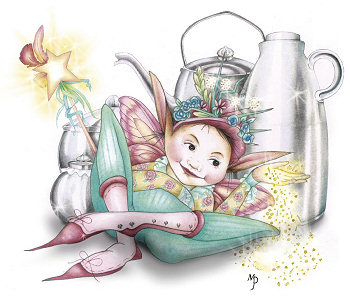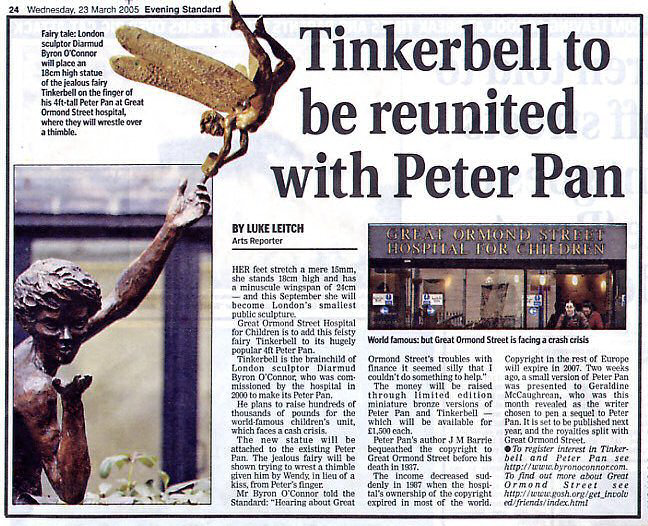Richard Dadd, The Fairy Feller's Master-Stroke (1855-64)
Oil on canvas, size 21.25 x 15.5 inches, Tate Gallery, London
Dadd was judged insane after he murdered his father in 1843, and he was committed to Bethlem Hospital. When Dr. William Hood came to the hospital as its administrator in 1852, he saw that Dadd could profitably fill his time with painting and gave him the supplies he needed.
The Fairy Feller's Master-Stroke occupied the artist for nine years (1855-64), but the strange work has yet to be fully interpreted and explained. What the painting means is obscure, but the content of the picture is made somewhat comprehensible by a poem Dadd wrote to describe the various figures and activities depicted; we know from his poem,
Elimination of a Picture & its subject--called The Feller's Master Stroke, that everything in the painting is intentional and that it is not simply a pastiche of mad delusions.
At the center of the painting is a figure Dadd calls "The Patriarch." He has a full white beard and wears an improbably huge hat with a papal-like, three-tiered crown. Fairies and elves dance on the brim of the hat, which twists off into tendrils and flowers to join the vegetation surrounding the Patriarch. The Feller, directly beneath the Patriarch, stands with his ax poised, awaiting the command to split a hazelnut in two; the
fay woodman holds aloft the axe
Whose double edge virtue now they tax
To do it singly & make single double
Featly & neatly--equal without trouble.
The two halves of the hazelnut will be used to build a chariot for Queen Mab. The allusion here is probably to the Queen Mab of
Romeo and Juliet (I, iv) who, Mercutio says, rides in a chariot created from "an empty hazelnut":
She is the fairies' midwife, and she comes
In shape no bigger than an agate stone
On the forefinger of an alderman,
Drawn with a team of little atomies
Athwart men's noses as they lie asleep:
Her wagon spokes made of long spinners' legs,
The cover, of the wings of grasshoppers;
Her traces, of the smallest spider's web;
Her collars, of the moonshine's watery beams;
Her whip, of cricket's bone; the lash, of film;
Her wagoner, a small gray-coated gnat,
Not half so big as a round little worm
Prick'd from the lazy finger of a maid;
Her chariot is an empty hazelnut,
Made by the joiner squirrel or old grub,
Time out o' mind the fairies' coachmakers.
And in this state she gallops night by night
Through lovers' brains, and then they dream of love. . . .
Dadd loved Shakespeare, and many of his paintings allude, even if somewhat tenuously, to various plays. One other detail in the painting draws two characters from
A Midsummer Night's Dream. Directly above the Patriarch stand Titania and Oberon (see the
detail), looking down on the busy scene of the painting. These two aspects of the painting are the only ones that have their source in Shakespeare, but if you wish to pursue the painting in more detail, David Greysmith, working from the text of Dadd's poem
Elimination of a Picture & its subject--called The Feller's Master Stroke , closely describes all the figures and actions in the painting (121-25).
As we look through the clutter of nuts and berries, the tangle of grass and stems in the foreground of this puzzling work, we glimpse a scene that is oddly fitting for a nineteenth-century visualization of
A Midsummer Night's Dream. This play was not, Richard Altick notes, ever performed in the eighteenth-century or the early part of the nineteenth as Shakespeare wrote it; instead, it had been adapted many times as a backdrop for opera and spectacle.
No matter when performed, or by whom, or with what text,
A Midsummer Night's Dream was a favorite vehicle for spectacular staging, especially the last act, which was treated much like a pantomime transformation scene. Both this play and
The Tempest were the chief Shakespearean beneficiaries, if that is the right word, of the rage for fairies on the stage and in art which was one of the more picturesque phenomena of popular culture in the 1840s. . . . Most
Midsummer Night's Dream pictures therefore were realizations in paint of the play's poetic imagery, its fairy and comic characters, and its never-never-land setting in a moonlit glade . . . . they were compounds of all that went to make up the early Victorian notion of the fanciful--lush arboreal landscape, moonlight, fireflies, the flora and fauna of the woods from a rich variety of flowers to capacious toadstools, assorted hovering or reveling fairies and elves. (Altick 264)
As bizarre as Dadd's
The Fairy Feller's Master-Stroke may seem to us, it reflects, along with fairy paintings by artists like Robert Huskisson, Daniel Maclise and Joseph Noel Paton, the nineteenth-century taste for a romantic, fairy and elf-ridden
A Midsummer Night's Dream. Nor does the tradition die in the twentieth century. The heritage of fairy paintings of
A Midsummer Night's Dream and the spectacular stage productions that look much like the paintings is revived by Max Reinhardt and William Dieterle in their 1935 black-and-white film of the play. The "ethereal forest" of the film, "with shimmering white balletic fairies racing through the trees and up moonbeams" to Felix Mendelsohn's incidental music for
A Midsummer Night's Dream, Jack Jorgens says,
carries on the spectacular stage tradition. Deer, owls, frogs, birds, and a unicorn inhabit a world of intensely back-lit ferns and rushes, lush grass and pools, flowers, and huge oaks. Shakespeare's lush imagery and lyricism have been stripped from the text . . . and embodied in chords of birch trees, cascading musical streams, and swirling fog and fairies shot in soft focus through gauzes or through smeared sparkling sheets of glass." (41)
The Reinhardt film looks as if the director went directly to painters like Dadd and Paton for the designs of his scenery, and the misshapen gnomes of
The Fairy Feller's Master-Stroke take their place in a twentieth-century motion picture.
We are urged, on the other hand, by Raymond Lister not to let the romantic and charming elements of Dadd's painting overwhelm us and prevent a clear reading of other possible implications of the canvas. "The picture," is, after all, he says, "a series of visions derived from the mind of its demented creator." In Dadd's painting of Titania and Oberon, as in Sir Noel Paton's
The Reconciliation of Oberon and Titania, there remain dark and sinister aspects; Lister draws our attention especially to several figures in the painting that are purely distorted and menacing:
The Feller is the centre of attention of the many characters in the composition, most of whom are, in one way or another, distinctly disturbing and malicious: the hard-faced, huge-calved ballerinas, the insect-like figure just above the Feller, and especially the little old man with a white beard, looking on with crazed concentration and appalled terror (plate 64).
http://shakespeare.emory.edu/illustrated_showimage.cfm?imageid=49
















